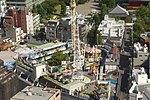Asakusa Culture Tourist Information Center
2012 establishments in JapanAsakusaBuildings and structures in TaitōKengo Kuma buildingsTourism in Tokyo ... and 1 more
Tourist attractions in Tokyo

The Asakusa Culture Tourist Information Center is a building primarily containing tourist facilities, amongst other amenities in the Asakusa district of Tokyo's Taitō ward. Along with its features, the building is also an attraction due to its architecture, as it was designed by Kengo Kuma, a noted architect. It is located directly across from the Kaminarimon and is open from 9:00 to 20:00. The center's motto is "Search, Show, Support".It was a recipient of the 2012 Good Design Award.
Excerpt from the Wikipedia article Asakusa Culture Tourist Information Center (License: CC BY-SA 3.0, Authors, Images).Asakusa Culture Tourist Information Center
Kaminarimon-dori, Taito
Geographical coordinates (GPS) Address Phone number Nearby Places Show on map
Geographical coordinates (GPS)
| Latitude | Longitude |
|---|---|
| N 35.7108 ° | E 139.7965 ° |
Address
龍昇亭 西むら
Kaminarimon-dori 雷門2-18-11
111-0034 Taito
Japan
Open on Google Maps










